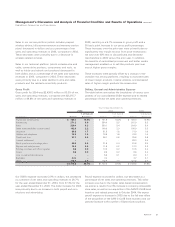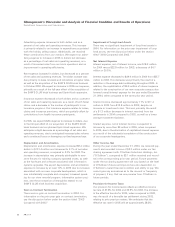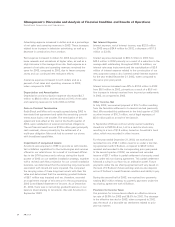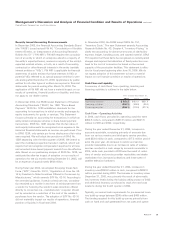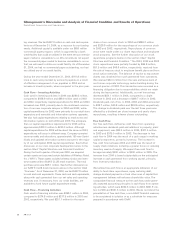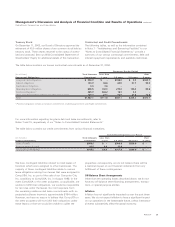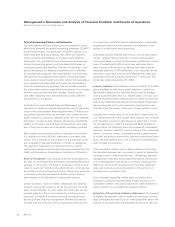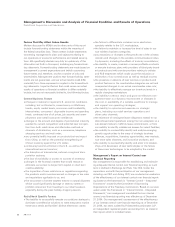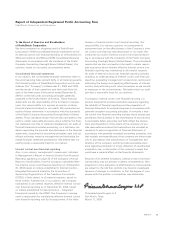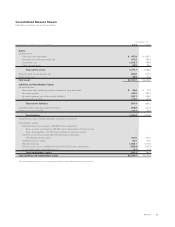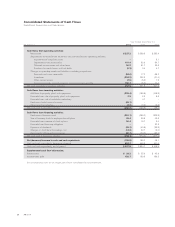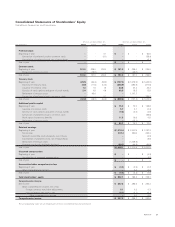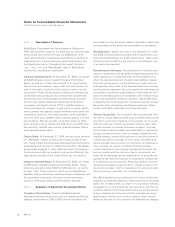Radio Shack 2004 Annual Report Download - page 32
Download and view the complete annual report
Please find page 32 of the 2004 Radio Shack annual report below. You can navigate through the pages in the report by either clicking on the pages listed below, or by using the keyword search tool below to find specific information within the annual report.
Critical Accounting Policies and Estimates
Our consolidated financial statements are prepared in accor-
dance with generally accepted accounting principles (“GAAP”)
in the United States. The application of GAAP requires us to
make estimates and assumptions that affect the reported
values of assets and liabilities at the date of the financial
statements, the reported amount of revenues and expenses
during the reporting period, and the related disclosures of
contingent assets and liabilities. The use of estimates is per-
vasive throughout our financial statements and is affected
by management judgment and uncertainties. Our estimates,
assumptions and judgments are based on historical experi-
ence, current market trends and other factors that we believe
to be relevant and reasonable at the time the consolidated
financial statements are prepared. We continually evaluate
the information used to make these estimates as our business
and the economic environment changes. Actual results
may differ materially from these estimates under different
assumptions or conditions.
In the Notes to Consolidated Financial Statements, we
describe our significant accounting policies used in the prepa-
ration of the consolidated financial statements. The account-
ing policies and estimates we consider most critical are: rev-
enue recognition; inventory valuation under the cost method;
estimation of reserves and valuation allowances, specifically
related to insurance, tax and legal contingencies; and valua-
tion of long-lived assets and intangibles, including goodwill.
We consider an accounting policy or estimate to be critical
if it requires our most difficult, subjective or complex judg-
ments, and is material to the portrayal of our financial condi-
tion, changes in financial condition or results of operations.
The selection, application and disclosure of our critical
accounting policies and estimates have been reviewed by the
Audit and Compliance Committee of our Board of Directors.
Revenue Recognition: Our revenue is derived principally from
the sale of private label and third-party branded products and
services to consumers. Revenue is recognized, net of an esti-
mate for customer refunds and product returns, when persua-
sive evidence of an arrangement exists, delivery has occurred
or services have been rendered, the sales price is fixed or
determinable, and collectibility is reasonably assured.
Certain products, such as wireless telephones and satellite
systems, require the customer to use the services of a third-
party service provider. In most cases, the third-party service
provider pays us a fee or commission for obtaining a new
customer, as well as a monthly recurring residual amount
based upon the ongoing arrangement between the service
provider and the customer. Fee or commission revenue, net
of a reserve for estimated service deactivations, is generally
recognized at the time the customer is accepted as a sub-
scriber of a third-party service provider.
Estimated product refunds and returns, service plan deacti-
vations, residual revenue and commission revenue adjust-
ments are based on historical information pertaining to these
items. If actual results differ from these estimates due to
various factors, the amount of revenue recorded could be
materially affected. A 10% difference in our reserves for the
estimates noted above would have affected net sales and
operating revenues by approximately $1.7 million for the
fiscal year ended December 31, 2004.
Inventory Valuation: Our inventory consists primarily of finished
goods available for sale at our retail locations or within our
distribution centers and is recorded at the lower of average
cost or expected sales price (i.e., market value). The cost com-
ponents recorded within inventory are the vendor invoice cost
and certain allocated external and internal freight, distribution,
warehousing and other costs required to transport the mer-
chandise from the vendor to the point-of-sale, usually a store.
Typically, the market value of our inventory is higher than its
cost. Determination of the market value may be very complex
and, therefore, requires a high degree of judgment. In order
for management to make the appropriate determination of
market value, the following items are commonly considered:
inventory turnover statistics, current selling prices, seasonality
factors, consumer trends, competitive pricing, performance
of similar products or accessories, planned promotional incen-
tives, and estimated costs to sell or dispose of merchandise
such as sales commissions.
If the calculated market value is determined to be less than
the recorded average cost, a provision is made to reduce the
carrying amount of the inventory item. Differences between
management estimates and actual performance and pricing
of our merchandise could result in inventory valuations that
differ from the amount recorded at the financial statement
date, and could also cause fluctuations in the amount of
recorded cost of products sold.
If our estimates regarding market value are inaccurate or
changes in consumer demand affect certain products in an
unforeseen manner, we may be exposed to material losses or
gains in excess of our established valuation reserve.
Estimation of Reserves and Valuation Allowances: The amount
of liability we record for claims related to insurance, tax and
legal contingencies requires us to make judgments about the
amount of expenses that will ultimately be incurred. We use
Management’s Discussion and Analysis of Financial Condition and Results of Operations
RadioShack Corporation and Subsidiaries
30 AR2004



